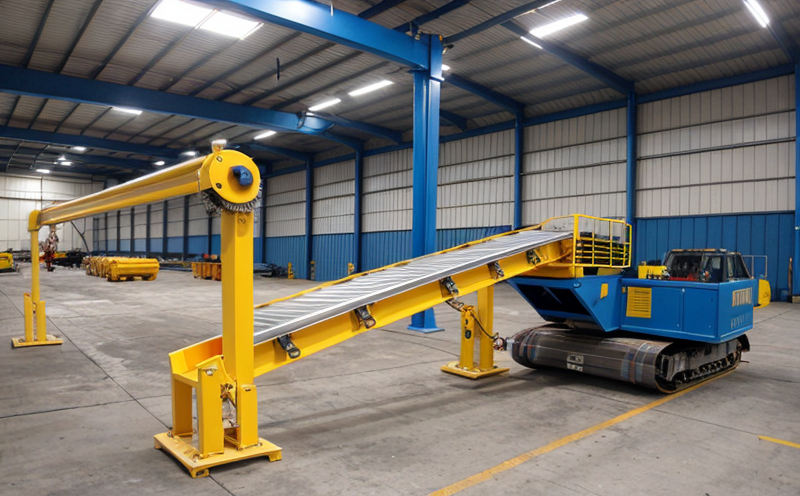ASTM E606 Fatigue Testing of Lifting Equipment Components
The ASTM E606 standard is a critical tool in ensuring the safety and reliability of lifting equipment components used in mining operations. This testing method evaluates the fatigue strength of materials under cyclic loading, which helps prevent failures that can lead to catastrophic accidents.
Conveyor belts, hoisting systems, and lifting equipment are subjected to high-stress environments where they must endure constant strain. The primary goal of ASTM E606 is to simulate real-world stress conditions by subjecting components to repeated loading cycles until failure occurs. This process allows for the identification of any weaknesses or potential points of failure before they cause operational disruptions.
For mining operations, this testing ensures that critical equipment can withstand the demanding conditions inherent in underground and surface mining environments. The test is not just about the material's strength but also its ability to maintain structural integrity under fatigue-induced stress over extended periods. This is crucial for maintaining safe working conditions and preventing downtime due to unexpected failures.
The ASTM E606 protocol involves a series of controlled loading cycles that replicate the operational stresses experienced by lifting equipment components in mining applications. The test setup typically includes a specialized machine designed to apply cyclic loads with precise control over parameters such as load magnitude, frequency, and duration. Specimens are carefully prepared according to standard procedures to ensure they accurately represent the actual components used in mining operations.
Once testing is completed, detailed reports are generated that document the fatigue performance of each component. These reports provide critical data on the number of cycles before failure, the type of failure observed (crack propagation, deformation), and any other relevant information. This comprehensive analysis allows quality managers and compliance officers to make informed decisions regarding equipment replacement or maintenance schedules.
By adhering to ASTM E606 standards, mining operators can enhance safety protocols and improve operational efficiency. The results of this testing are invaluable for R&D engineers in refining designs and improving the robustness of lifting equipment components. For procurement teams, these test results serve as benchmarks for selecting high-quality materials and suppliers.
Understanding the nuances of ASTM E606 is essential for those involved in mining operations. This standard plays a pivotal role in ensuring that all critical lifting equipment used in mines meets the highest safety standards. By implementing this testing protocol, mining companies can significantly reduce the risk of accidents and extend the lifespan of their equipment.
Moreover, ASTM E606 fatigue testing is not just about compliance; it's about fostering a culture of continuous improvement within the industry. As technology advances, so too must our understanding and application of these standards to ensure that mining operations remain safe and efficient.
Benefits
The implementation of ASTM E606 fatigue testing offers numerous benefits to mining companies:
- Enhanced Safety: Ensures that critical lifting equipment can withstand the rigorous conditions found in mining environments, reducing the risk of accidents.
- Increased Reliability: By identifying potential points of failure early on, this testing helps extend the service life of equipment components, minimizing downtime and operational disruptions.
- Improved Efficiency: With more reliable equipment, mines can operate at peak efficiency, contributing to overall productivity gains.
- Cost Savings: Early detection of weak spots through fatigue testing can prevent costly repairs or replacements later on.
- Compliance with Standards: Adhering to ASTM E606 ensures that equipment meets stringent industry standards, facilitating smoother regulatory compliance processes.
- Sustainable Operations: By enhancing the longevity and performance of lifting equipment, mines can minimize their environmental footprint by reducing waste associated with frequent replacements.
In summary, ASTM E606 fatigue testing is a cornerstone for maintaining safety, reliability, efficiency, and sustainability in mining operations. Its comprehensive approach to evaluating lifting equipment components ensures that these vital pieces of machinery are up to the task of meeting the demands of modern mining environments.
Industry Applications
The ASTM E606 fatigue testing method is widely used across various sectors within the mining industry, particularly for critical components such as conveyor belts and hoisting systems. These applications are crucial given the harsh operating conditions faced by equipment in underground mines.
Conveyor Belts: In underground mining operations, conveyor belts transport materials over long distances, often in challenging environments where they endure significant stress. ASTM E606 fatigue testing ensures that these belts can withstand the repeated loading cycles without failure, thereby enhancing operational safety and efficiency.
Hoisting Systems: Hoists play a vital role in raising and lowering equipment and personnel within mines. The cyclic nature of their operation makes them particularly susceptible to fatigue-induced failures. Testing according to ASTM E606 helps ensure that these systems remain reliable under continuous use, which is essential for maintaining safe working conditions.
Lifting Equipment Components: Various components such as pulleys, sheaves, and chains are integral parts of hoisting and lifting operations in mining environments. By subjecting these components to fatigue testing according to ASTM E606, mines can ensure they meet the highest safety standards before deployment.
The rigorous testing process outlined in ASTM E606 is designed to mimic real-world conditions as closely as possible, making it an indispensable tool for maintaining the integrity of lifting equipment used in mining operations. This ensures that all critical components are capable of withstanding the cyclic loading they experience during operation, thereby enhancing overall safety and operational efficiency.
Environmental and Sustainability Contributions
- Reduced Waste: By extending the lifespan of lifting equipment through rigorous fatigue testing, mines can minimize the need for frequent replacements, thereby reducing waste generation.
- Energy Efficiency: Reliable components that pass ASTM E606 testing contribute to more efficient operation, leading to lower energy consumption and reduced environmental impact.
- Material Optimization: The data generated from fatigue testing helps in optimizing material selection, ensuring that the most suitable materials are used for critical applications.
In conclusion, ASTM E606 fatigue testing is a vital tool in promoting sustainable practices within mining operations. By enhancing equipment reliability and longevity, this testing method supports broader environmental goals while maintaining operational excellence.





